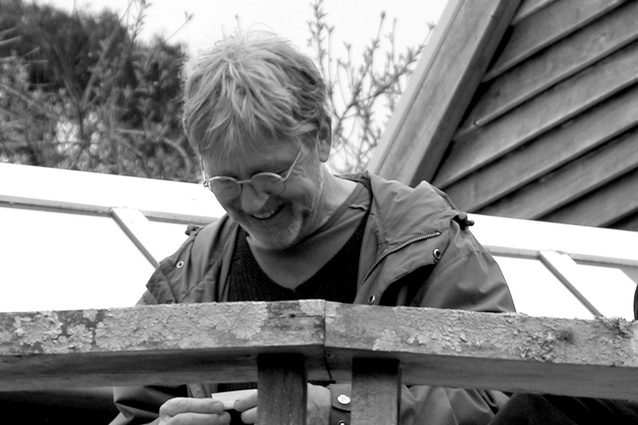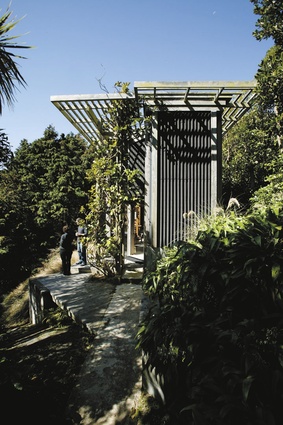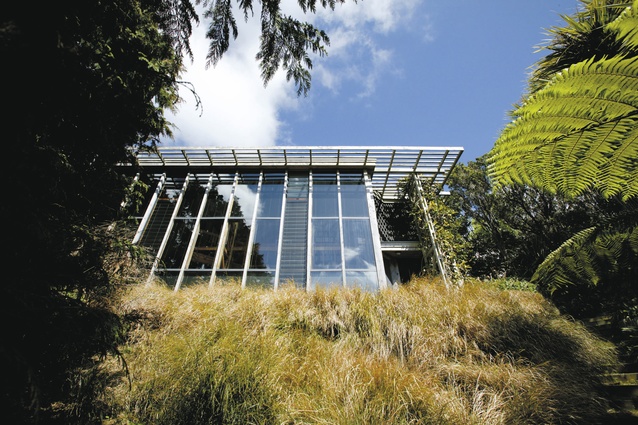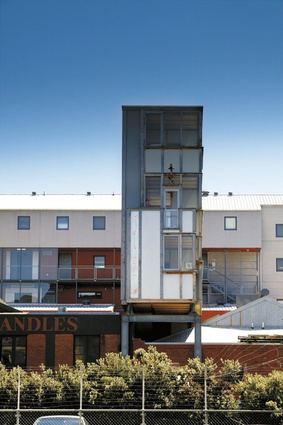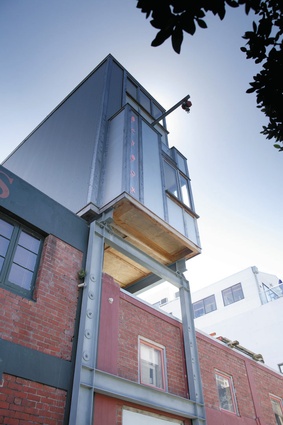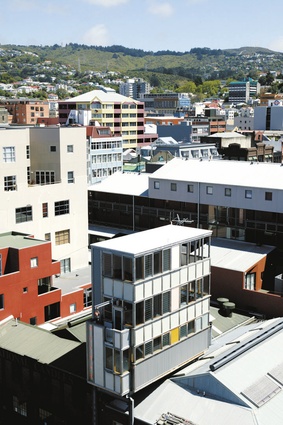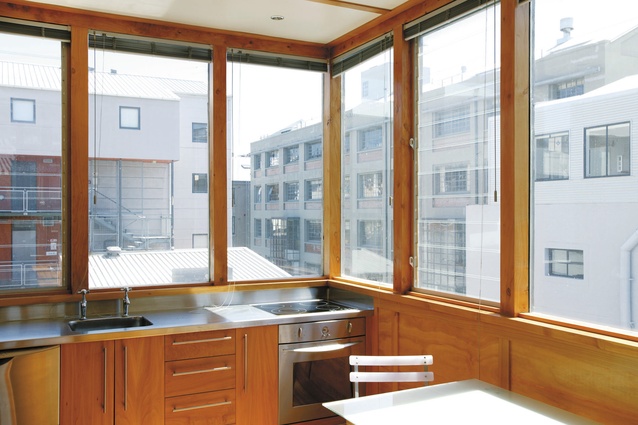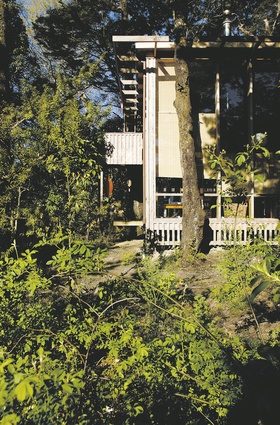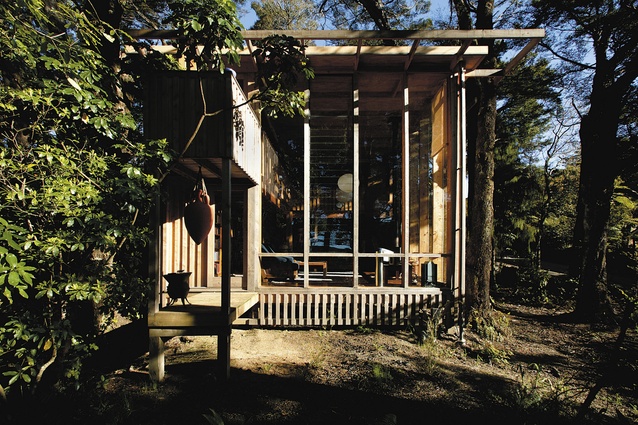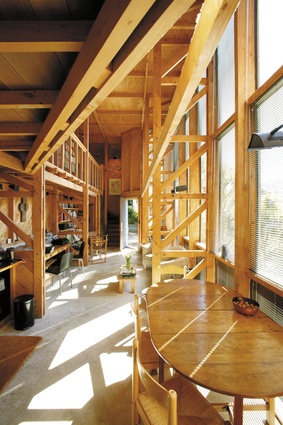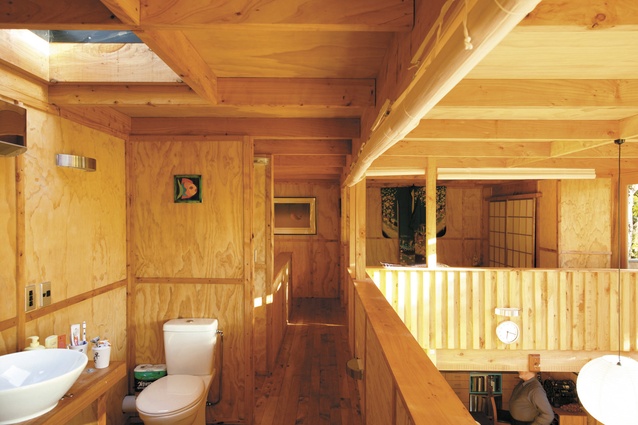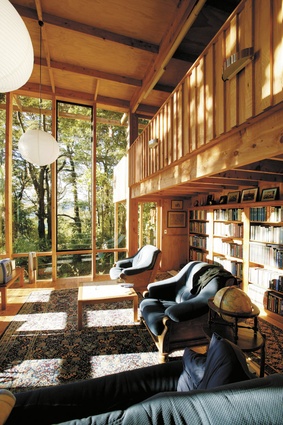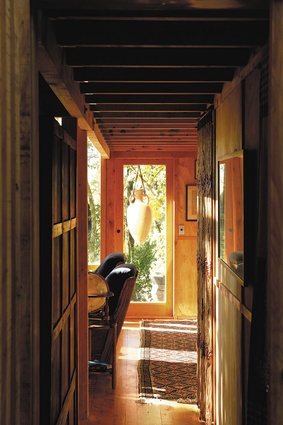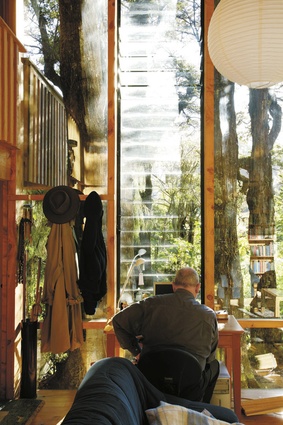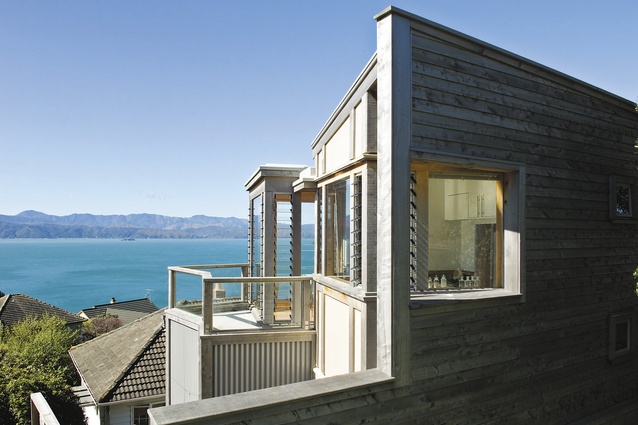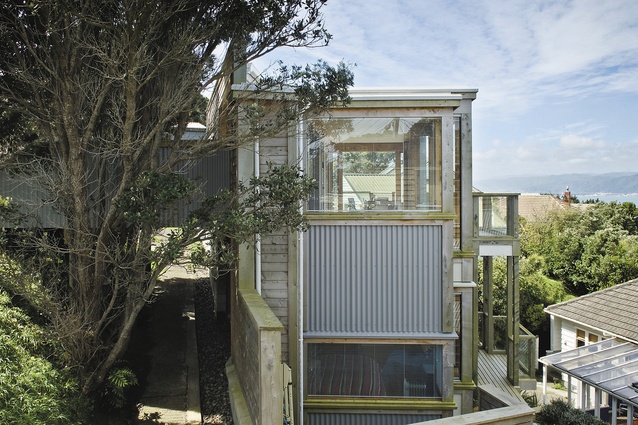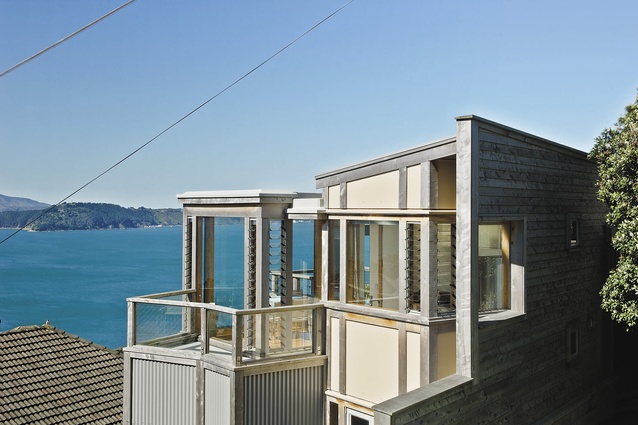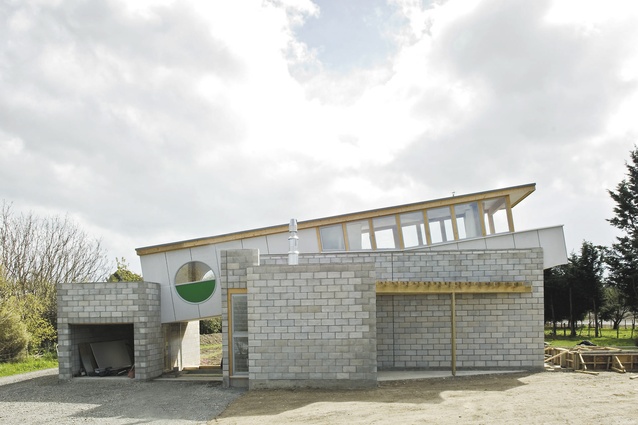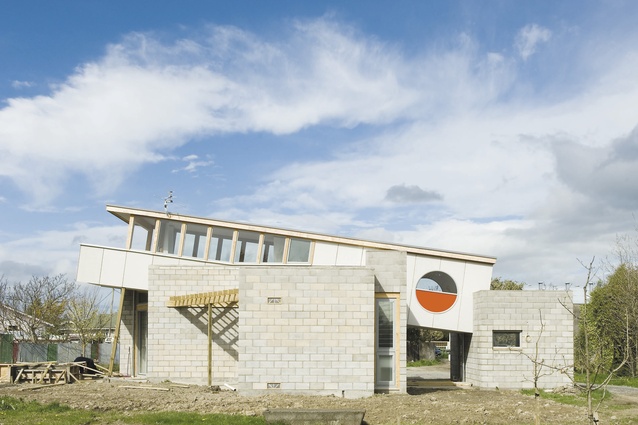Gerald Melling remembered
Sadly for New Zealand architecture Gerald Melling passed away in Wellington on 22 December 2012. To remember the architect, and to provide some insights into the life of this "free and restless spirit", here is a reproduction of his lengthy 2007 interview with Houses magazine.
Nobody’s soldier. Liverpool-born Gerald Melling, partner in the Wellington practice Melling:Morse, is a free and restless spirit who has pursued his passions for architecture, literature and journalism for more than four decades. He talks to John Walsh about his careers.
John Walsh: Let’s start back in Liverpool. Why architecture?
Gerald Melling: Oh God, why architecture? I can’t answer that definitely, except that the only things I actually showed any interest in… at my tedious grammar school were English and art and football, not in that order. I had a lovely old art master who had us doing interior perspectives of buildings, mostly of gothic churches, to teach us how to craft light and dark and shadow. That got me looking at buildings and, of course, Liverpool then was full of gritty buildings, stained from all the pollution we accepted in those days, and I loved them all. I really felt kind of secure amongst all those big, grimy buildings…
I remember telling my art teacher I wanted to be a commercial artist. I had no idea what that meant, just that I wanted to be an artist but make a living as well. He said, ‘why don’t you think about architecture?’ And there was something else… When I was quite young, beginning to look at buildings, I started seeing all these large private houses and estates in the countryside. I used to think, ‘why is it that people can live in such opulent places on the one hand, while for the rest of us, that is, my community, housing is so drab and unimaginative?’ This wasn’t a jealousy of wealth – it didn’t occur to me that I should object to them being wealthy, but I thought, ‘why can’t those elements be in our houses on a smaller scale? Why isn’t there the same attention given to where I live as to where these people live?’ That really got me going as well.
I had to leave school at 16 because my old man was unemployed but I was quite happy to leave. In those days – this would be 1960 – they had a part-time course for architecture.
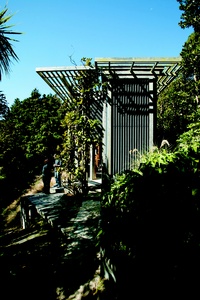
Still in Liverpool?
Still in Liverpool, yeah. You could work as a cadet in an architect’s office and do part-time work at a university, but what happened to me – and this probably explains my entire attitude to the rest of my life, so are you listening carefully? I couldn’t get a job in an architect’s office. It wasn’t easy in those days, a scruffy bugger wandering around trying to find a job… I got a temporary job for £6 a week at the Lister Drive Power Station, as a clerk, next to an abattoir. It took me about nine months to get a job with this little architectural practice in Liverpool which paid me £3 a week. I was thrilled to bits to get this job and these guys would train me up.
Then the RIBA withdrew the programme. I was completely devastated … The architect I was working for wrote letters on my behalf to try and get them to let me sneak in, but they wouldn’t. That experience has kind of defined my attitude to the great architectural profession ever since.
How did you cope with that?
There are a lot of coincidences in life, aren’t there? This was the early ’60s, and I had other interests. I wanted to be a writer and I was going to Liverpool folk clubs, listening to people like Roger McGough and Brian Patten and Adrian Henri… I really got into writing poetry. The place I was working for was an architecture and quantity surveying firm – they did both, and one of the awful things they tried to teach me was quantity surveying. I used to borrow, so to speak, big wads of this quantity surveying takeoff paper – lovely stuff, thin paper with vertical lines in different, pale colours and almost imperceptible little horizontal lines. I took it home and wrote my first novel on it.
So you had your first novel written by the time you were 20?
Before I was 20, yeah. It was appalling, of course. I sent it to Grove Press in New York, publishers of Kerouac and all the rest of the boys, you know… I had, like a lot of other people in my generation, the great awakening. Suddenly, my hair was down to my arse and I wanted to get out of there. I had to save some money to get a ticket to get over to the States, so I went and worked at Bootle Town Hall as an architectural assistant.
Were you also getting qualified at this time?
No. I went to night classes at Liverpool Technical Institute to take all this construction stuff but I ended up having a fight with the tutor and got expelled so that was the end of that. So it was all just my own reading. I was still totally fascinated by what I saw as the possibilities in architecture…
Would you say that, historically, you’ve had a bit of a problem with authority?
Oh, totally, yeah, yeah. I could never have been a soldier, let’s put it that way. I’m nobody’s bloody soldier. I’m quite happy to be part of a team but I want everything well explained to to as to why I should jump when somebody says jump.
New York was where you wanted to go when you left Liverpool?
I just wanted to go to North America… Architecture was gone by then in my mind. This was me trying to be a poet, a writer, connect with that whole kind of sub-culture…
This is in the mid-’60s?
Sixty-five was when I went over there, but this was all going on in my head before I went to the States, of course… I was really into Jean-Paul Sartre, Samuel Beckett and then the Americans. I used to sit and read Howl and I thought Kerouac was amazing. Just that whole kind of freedom thing, all totally future, no looking back at all. It was real hedonistic stuff really. And I had this vague spiritual side… What did we used to call it then? Cosmic consciousness? It was all very fascinating when I was that age. I was very interested in Buddhism.
This hasn’t left you totally, has it?
No, it’s all in there. It all mixes up. I don’t believe in any of this stuff but I remain interested in it… There’s a huge gap, isn’t there, between being interested in ideas and actually yielding to them? I’ve never been able to do that, which is the same thing with authority really. I can’t do it. I’d rather make my own decisions.
You’re not a joiner.
No. The only joining thing I could do was play in a football team and, even then, I didn’t join in the social side of it. I would have a game of football, this is in New Zealand, I would have a good game of football on a Saturday and get rid of a lot of frustrations, get changed in the dressing room, maybe have a glass of lemonade and then go, while the rest of them would all get pissed.
What position did you play?
I used to be a glory boy but then gradually you go to the back, don’t you? Midfield, and then you’re the traffic cop.
Back to North America… You went to Toronto and stayed there for a while?
I went to New York first. I got in as a tourist but I knew in advance I wouldn’t be able to stay in America unless I was prepared to be drafted and that was serious business… Even apart from the draft, I don’t think I could have done it – you know, the old hand on the Bible and swear loyalty to the president. So I mucked around in Greenwich Village for a while and then took off to Toronto.
In those few years I spent on the continent, I’d move from enclave to enclave within each major urban conurbation, between the places where all the hip people were, so to speak – where the counter-culture lived. It was so extreme in the mid to late ’60s. Honestly, you may not believe it now, but to have long hair would inspire local thugs to come and beat you up. It was amazing – you’d spy another person across the street with long hair and it would be ‘hey, man’… In Toronto, they had a place called Yorkville, which was its Greenwich Village, and Vancouver had Kitsilano and San Francisco had Haight-Ashbury and so on. We used to move from one ‘village’ to the other. You didn’t relax on your journey until you were in the embrace of this culture.
You were editing a newspaper?
Yeah, Satyrday, an alternative paper in Toronto. A monthly.
If you kept it together?
Oh, no, we were disciplined… There was a whole community of newspapers from all these different ‘villages’ – it was called the Underground Press Syndicate. Satyrday was one of the weirdest of them all. We were the first to drop out of the Underground Press Syndicate, that’s how difficult we were… They had, on the face of it, a lovely idea that anything that was published in an underground magazine, as an editor you could pick up without worrying about copyright. That’s how I came to publish so much of [Charles] Bukowski… But we got really f….. off because quite a few newspapers weren’t contributing anything original themselves… I was only 22 or 23 years old. It was great.
Were you doing any architecture in Toronto?
Occasionally I supported myself by working for an architect… They’d pull me in if they were going to do a competition or something. I’d go and live above the office and crank this stuff out… So I kept my hand in architecturally and I was still really interested in it, it’s just that it wasn’t the main event in my life. But by the time ’69 came it was completely clear to me that this whole counter–culture had lost all its edge. For me and a lot of other people who’d been involved since the early ’60s it was all over. We had to look for somewhere else to go… We had to drop back in somehow.
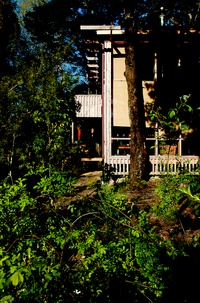
So I just bought a ticket – me and my then-wife – bought a ticket to Trinidad and got on a tramp steamer out of New York. That was an amazing trip, months and months… The captain would get calls from the head office in New York, ‘can you get over to Caracas, mate, and pick this up?’ and off you’d go to Caracas. One of the biggest regrets of my life was that that boat, after we got off at Port of Spain, went right up the Amazon to Peru, but I didn’t have the money to stay on it any more.
We went to the West Indies because I’d decided, then, that I had to kind of get to grips with the architecture business if I wanted to make a living. I was even then wanting to work at the lowest possible level I could find – don’t ask me why, but that’s what interested me. But I couldn’t get a job. I tried several islands… and then at Port of Spain, I made a call from a phone box on the quay and the next day I was in the Immigration Minister’s office. I’ll never forget it. He sat back, a really laid–back West Indian with shades on and he said ‘White boy, the day every black man on this island has got a job, we can offer you one’. How could you disagree with that? So that was that. We tossed a coin – it was Canada or England. So back to the UK… and when we got back we discovered my wife was pregnant so I got a job in Oxford for a couple of years, where my two kids were born.
Working for an architect?
Yeah… hopeless bloody architects really. Lovely little office, right in the middle of Oxford… We used to live in this little flat on the towpath of the canal that runs right through the middle of Oxford. Yeah, amazing… That’s when James Stirling was building the Florey Building [Queen’s College, Oxford, completed 1971]. I thought ‘that’s really, really good’. All the local architects hated it… I was still restless as hell. I didn’t really want to live in England. It seemed to me that you had to be really wealthy to survive there…
Did you want to go anywhere in particular?
Just somewhere else. I applied for a job in Uganda and went down to London for an interview with this dude who looked like Somerset Maugham… He said to me, ‘Gerald, thank you so much for coming down to see me. No problem in your ability to do the work but I really can’t see you fitting into the ex-pat culture out in Uganda.’ He was really kind of gentle.
And probably quite wise.
Oh, yeah, and I was very pleased to hear this from him because it saved me from saying it to him and a week later Idi Amin rolled in and tore the place to bits… Then I applied for a Solomon Islands job and also for one in New Zealand. I knew nothing about New Zealand except I’d heard of Miles Warren and I’d heard of James Baxter and Katherine Mansfield and knew there were a lot of trees here, not so much the sheep, actually.
A slender basis for migration.
Yeah, incredible isn’t it?
And fetched up and lived out in Porirua and worked for the Ministry.
Yeah, the Ministry of Works. I didn’t even know where I was going to be working.
Did you even know what city you were going to?
I knew I was going to Wellington. The boat came to Auckland and we came down on the Silver Star… I think when you got to somewhere around Paekak, the guy would come through waking everybody and I came out into the corridor just as the train burst through the tunnel, through the Ngauraunga Gorge on a beautiful, beautiful day. It looked just like San Francisco, this place…
Then we got into the station and we were climbing down off the train onto the platform and we turned round and there’s a unit on the other side of the platform, right there in front of me, with ‘MELLING’ written across the top. For a moment I thought this was all good, and then they took me out to Porirua East…
How long did you last in the Ministry?
About 18 months and I had to pay back the money I didn’t have. The Ministry is where I met Allan [Morse]… He was the only person I could relate to. I hooked up with Martin Hill and started a practice with him called Synaxon Group that I think is still going. I made up the title. Can you work it out?
You’d better tell me.
Syn, you know, together, axon – nerve centre, the bringing together of the nerve centres. How turgid is that…
What did Synaxon design?
We did quite a few things. It was a great learning curve for me because I took a lot of responsibility there. We built little houses, some quite interesting flats on top of some shops in Maungarakei, single storey shops, a suburban shopping centre… But it only lasted a couple of years and then I got sick of architecture. I’m a bit like this, when I look back… I took a job as assistant editor of Designscape. Tim Nees’ father Geoff pulled me in. That was quite fun. I was with them for 18 months and then I went up to Auckland – that’s about ’76 now – and finally got myself qualified… Allan Wild was the dean.
How was it, going back to school?
It was fine. In fact, I was working as a roving journalist. I’m forever grateful to Geoff Nees – he kept me on the payroll. In between doing what I was doing at the School of Architecture, I was writing articles about what was going on up there. Allan Wild let me go back before my time was up. He said ‘go back home and see your kids, it’s alright’.
When you came back, did you start your own practice?
No, I worked for Ross Webb. For a brief time he’d been a partner with Craig, Craig and Moller. He had this big beard and glasses and all the hair, but he was so clean and impeccable, his jeans were almost pressed. There were three of us. I was in the upstairs bedroom on a drawing board and the other two were downstairs with their headphones on listening to Exile on Main Street…
I presume that didn’t last long?
No, that was brief. I think it was Dave Launder who told me there could be a job for me at the Wellington Education Board. I’d always had this interest in education – it was a reaction to the education I’d had. I was into A. S. Neill [the Scottish progressive educator who founded Summerhill school]. I was amazed that it had become government policy in New Zealand to have open plan teaching systems. I’d seen some of the early open plan things and they were terrible, really clumsy, but I was still really interested… So I went down to the Board and got a job and I was there too long – about six years. The first three or four I really enjoyed and then it became terrible because they sussed me out and I couldn’t get anything built.
I remember going to the office, on top of a building in Abel Smith Street. It was 1977, but it could have been the 19th century. It reminded me of those old pictures of insurance clerks in northern England. A ceiling of horizontal fluorescent lights and all these neatly stacked desks with all these heads down on the drawing boards facing one way and a draftsman on a raised dais, looking over them. Draftsmen weren’t allowed to go out on building sites.
I remember saying to the chief architect, ‘I’d love to come and work on this stuff but on condition that you let me reorganise this office and the way it works’. And he gave me something from the kitty to actually do something. I separated the whole lot into different teams and built all these partitions. I took all the ceiling tiles out and opened the place up. I formed this space in the middle called the library and took a couple of the boys down to a second-hand shop and bought these old beaten-up couches. It was like a Ponsonby flat. Without telling anybody I subscribed to The Architectural Review, Domus, Progressive Architecture… I had all these administrators saying, ‘What’s this, what’s this?’ I said, ‘the boys have got to read this stuff’.
Even then, the soccer analogy was there. It was easy to see who had some clues and who hadn’t. I had these four teams – one was Division 1, one was Division 2… The funny thing is that the people who were in Division 4 were happy about it. They got work that they could cope with. They weren’t insulted. They used to get the toilet alterations and redesigning the playgrounds and getting the sumps in the right place and they were quite happy because they could do that… We really enjoyed ourselves and everyone got out on site. The whole thing loosened up.
Tell me a bit more about the culture of the old Education Board.
What actually happened at the Board was quite tragic really. There’s this whole thing about communicating architecture – I’ve always wanted to communicate what architecture can be to people who may not be aware of it. It’s a semi-missionary zeal. That’s why I’ve always been interested in architectural magazines, whether they’re good or not. So I put Worser Bay School in for a local branch award – I was a member of the Insititute then – because I thought, ‘I want people to see what we’re doing here’. It got an award. We were all rapt, having a little bit of a party in the office, and then I got summonsed to the general manager’s office. I thought I was going to be congratulated, so off I trotted, happy and I got a dressing down. I was accused of being a sort of show pony…
You know what happens to tall poppies…
I was absolutely stunned… At the beginning of the year, the Education Board used to have such potentially wonderful jobs coming in – the sort of jobs a private practice would give its right arm for [but] it got to the point after I’d been there for three or four years where anything that had my signature on, they would just sit on it.
And then you returned to editing?
I started my own practice and almost the same year I applied for, and got, the job of editor of New Zealand Architect. I was Gordon Moller’s successor.
I was looking at some of the issues of the magazine that you edited. They were pretty lively. Your reign was brief but glorious.
Three years, mate, and it seemed like a f……. eternity. I used to lay the whole thing out. I’ve got them downstairs, they’re all falling to bits now. You can see the back of all the tape coming through the pages and all that. They’re fragile.I loved it. I was so committed. It was just madness, really, because I wanted to bring this criticism… I used to hire all these writers who couldn’t write, all these architects who couldn’t write, and re-write it for them and they didn’t object. It was just amazing, but it was great.
And then you found out that New Zealand architecture wasn’t quite ready for criticism.
I knew it wasn’t – I wasn’t naïve about it. I told them when they interviewed me for the job that that’s what I wanted to do. There was nothing kind of sly about it, but I don’t think they understood what it meant. I honestly don’t think they understood what it meant, you know.
And how did it end Gerald?
With an abusive letter from an Institute gentleman – a f… off letter.
So then it was back to practice?
Well, I was doing my practice during all that, of course, so yeah, I just hung my sign out on the door and off I went. I was on my own for about seven years… I rented an office on Abel Smith Street, right opposite the Education Board.
You seem very much at home in Wellington.
I think Wellington is what’s kept me in New Zealand really. It’s that first day, when we came roaring through that tunnel.
You don’t just do houses now do you?
Yeah, basically. Well, we’ve done other things – Butterfly Creek by Auckland Airport, and Trash Palace [recycling facility in Porirua]…and a few commercial things, of course, but predominantly, it’s houses.
Have you always given your houses little pseudonyms?
No, that’s relatively recent. It started off with the Music Box, which was the Pugh House. They’re not all ‘boxes’ – it was the Wedge last year and we’re doing one called Glass Palace now on Oriental Parade… Allan [Morse] and I started by doing a housing scheme – if our practice aspires to something bigger, then it’s the movement from the individual house to a community of houses. That’s what really gets us excited. Melling:Morse started because we won the John Tait Village competition in Avondale, in Auckland. That’s what brought us together.
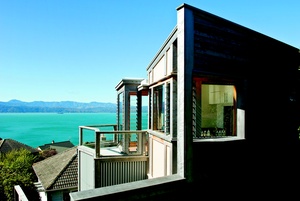
We’ve done some smaller schemes – we did one in Porirua, just round the corner from where I first started, which was a bit weird. It was shelter housing, for battered wives… We’ve designed so many schemes, but there always seems to be a failure of political will to actually realise them. We did one at Pomare in 2000. Do you know Pomare? Up where Lower Hutt ends and Upper Hutt sort of hasn’t quite begun – the first place the Lower Hutt cops go if there’s someone they want to find for some misdemeanour. We workshopped with all the local people who were managing to live there – most of them were Mongrel Mob people – and produced this really good document. Creative demolition we called it and gave the Housing Corp a rough idea of what we thought the investment would be, and then they just ran away from it – too much money.
Over the past few years a series of your houses has been published – houses designed for individual clients to challenging budgets. It seems those clients have got a lot of architecture for their money.
I’m pleased you said that but the publicity is sort of coincidental… Douglas Lloyd Jenkins is responsible for a lot of it. For some reason, he liked what we were doing and, suddenly, we had some attention that we hadn’t had before… My view is that we’d just been under the radar before. We haven’t done anything different suddenly. Hopefully, we’re improving… but this is what we’ve always done and we’ve had our stuff in magazines down the years.
Did what Douglas think you were doing accord with what you thought you were doing?
Oh, pretty much. He seemed to share my cynicism about the kind of, you know, the cloning of reinvented modernism.
How do clients find you and what sort of people are coming to you or have been coming to you?
Usually, people are pretty informed about what we do before they come to us. The recent attention we’ve had is directly related to the Institute. When I finished being editor, I resigned from the Institute. Particularly after my abusive letter, I decided that ‘you can all get f…..’ That sounds silly, but for me, it’s a question of identity. I couldn’t identify with this group. I thought, ‘you don’t seem to like me particularly and I certainly don’t like you’.
Now I’m talking about the group. Within that group there’s lots of architects I really like… It’s a bit like my days in America. I knew a lot of Hell’s Angels guys and, as a mob, they are terrifying, they’re awful, but some of them as individuals were lovely people. It’s amazing what happens sometimes when people become part of a group and I see that with architects. I still shiver when I got to any kind of function where there’s a lot of architects. Honestly, I just clam up, but I can talk to any one of those guys if I meet them individually in the street.
Anyway, not being members of the NZIA, we can’t enter their awards. We were faced with marketing ourselves – we’ve got to get some work somehow. Then I ran across Home and Entertaining’s Home of the Year award. We put the Pugh House [the Music Box] in and it’s gone from there… It wasn’t just marketing. We were looking at all these big houses and we thought, ‘wouldn’t it be great if we can get these little houses in – start showing people you don’t have to be a millionaire to have architecture?’
Small houses, of course, often take just as much work as a big house.
Oh, totally… I went to a Home of the Year do for the Samurai House – it was in some flash building in downtown Auckland. I don’t know how we’re perceived by other architects but I have my suspicions, so I always make sure that I kit myself out pretty sharply. I’ve got my Hugo Boss leather jacket which comes out for special occasions… So I’m wandering round and the other finalists all came over to me. They’d seen John Jarvis, the Samurai House client, talking on TV about his $100,000 house, so they were sort of saying to me, ‘is this for real?’ I said, ‘well, it is and it isn’t, you know. There’s no contract, he’s sort of run it himself so that’s how it has actually been done. Basically all you do is work twice as hard for half the fees’. ‘Ah’, they said, and that was the end of the conversation.
When did the Sky Box get built?
Mostly during 2001… I had split up with my wife and had nowhere to live. Suddenly, it came to me that Allan and I own this building. We’ve got a building site up there, free. I pinched the best bit, right on this corner with the sun coming in. I designed this thing and went out to tender with it. The lowest price I got back would have broken the record for domestic square metreage in New Zealand. They couldn’t figure out how to price the risk in bringing everything up here. One of the contractors had priced to build a series of steps in the courtyard at the far end of the building and a huge kind of causeway across over the roof, with site huts to have cups of tea… There’d be a hundred grand there.
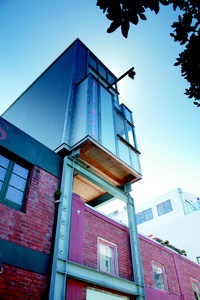
So I just hired a couple of chippies I knew and said, ‘come on boys let’s get going’. I had this really awful meeting with the City Council and I was coming up the road and suddenly, oh Jesus, they were standing on this roof putting the frames up, not a scaffold anywhere. I’d forgotten all about the scaffolding. So I had to get that bloody hassled up quick but they wouldn’t give me a resource consent because they said it had to have a wind tunnel test… They have a device for testing things like the BNZ Black Box, for God’s sake, that might blow over old ladies in the street… They had this rule that said anything that was four storeys or more had to be tested and I said this is bloody nonsense – it’ll cost me 15 grand.
[The Council] kept calling me back to meetings and a new guy arrived to head the resource consent team who was quite co-operative… I said to them, ‘look, how high is four storeys anyway?’ There was quite a silence. Of course, everyone had a different answer. How long is a piece of string? So the new guy just said, ‘we’ll call four storeys 18 metres’. That’s a metre higher than this is. So that’s how I finally got my resource consent… Another groundbreaking rule from Melling:Morse.
Is it getting harder to build?
Yes, being an architect is getting harder. Well, for me it is, it may not for younger folk, but all this CPD stuff… If you look at other professions and you talk about continuing professional development, you can see what it’s about and you can see the necessity for it – you know, medicine for instance… Look, I put my effort into running the practice and trying to develop that. I’m continually professionally developing – or I bloody well should be, you know.
How many are in your practice?
Just the four of us.
Do you still enjoy it?
Oh, I love it… Most of the stuff I hate is to do with bureaucracies and the architectural profession, not architecture itself.
What are the projects you’ve especially enjoyed?
Oh, quite a few, going back quite a bit, and not just houses. Some of my schools I was really into – Worser Bay School, I’m very fond of – even though they get over-written. Spring Creek School – I loved that but it has been completely f….. My son wrote his thesis on over-writing of architecture. It’s amazing how vulnerable buildings are.
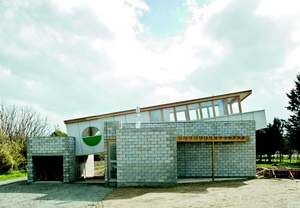
Is your son an architect too?
Yeah. He’s just over in Victoria Street. Architecture Central is his practice.
Is he competing with you for business?
Oh, God no. There’s plenty for everybody. I’ve never felt kind of competitive in that sense. I get pissed off, but it’s our own fault… It isn’t just awards that we’ve kind of penalised ourselves for. Allan and I… we’re not people who play golf and join yacht clubs.
If you look at your houses can you see a common direction?
Yeah, totally. Clear as a bell.
So where are they going?
Well, where we want them to go… Like I said, I want to do communities of houses – that’s what I really want to do now. There’s still something totally seductive about doing small houses in difficult places and trying to come up with a fresh way of looking at it, but that’s what I’d like to move to next…
Do you think architecture is getting better in this country?
The quality of building has always been there. It’s a question of whether you can afford it. The quality of design – perhaps, but architecture is far more than design.
Such as?
All the other things. It’s the people, it’s being appropriate… How can architecture work on a much broader scale? The thing that almost makes me weep is that so few architects, and particularly those who I think are good architects, seem interested in engaging with architecture at that level. Where architects are needed they’re not going. We really need architects to engage in low cost housing. What I want to see is good, experienced architects engaging in this. That’s what it needs. It’s one of the hardest things there is to do, low cost housing, to make an environment for people that really supports them.
You’ve not only got to be interested but you’ve got to stick with it. When I got involved with a project in Sri Lanka recently I was very impressed when I first met the people from the office I was working with. They were doing all this work for the refugees from the tsunami for nothing. But what I’ve realised since is that they have then given the responsibility for the job to the most junior and most inexperienced person in the office.
How did your involvement in that Sri Lankan project come about?
The [VUW] School of Architecture were sending a group of students to Sri Lanka to study tsunami reconstruction, and I thought I’d love to go with them and try to find some work. It’s something I’ve always wanted to do – it goes right back to the bloody Caribbean Islands for me. So I went over to talk to Gordon Holden [Head of the VUW School of Architecture] and I said, ‘are you interested in having a practitioner go along – I’ll pay my own way’. So I went with them. When I was over there I looked for a job and fluked one.
How has it gone?
Oh, I don’t know. I’m going to go back again. I’ve already been back once because it was all falling to pieces and I had to start kicking walls over on the site and all that stuff, which I hate. I don’t know what I’m going to find when I do get back but I plan to document the project. I’d love to write a book about it – it’s a topic that needs a really good book… All the literature I read about emergency housing – or permanent housing after an emergency – is talked about in too-holistic a way. You can’t actually grasp it. What you need to do is take one example of an actual built project. Make it more real.
Would you like to do more of that sort of work? Do you want to work in other places?
Oh, it always excites me… I can be a bit romantic, I’ve got to be careful. But Sri Lanka was a phenomenal experience for me. I got heaps out of that. People congratulated me for my altruism, but it was take, take, take as far as I’m concerned. I came back full of Sri Lanka – ain’t no island full of me. It was just a wonderful experience. When I came back I asked if I could get some CPD points for it. ‘Not relevant’, is what came back on the computer.
Gerald Melling, 1943-2012, Selected publications
Home: New Directions in World Architecture and Design, Bateman, 2006
Architecture Inspired by New Zealand, Mint Publishing, 2006 Exquisite Apart, NZIA, 2004
At Home: A Century of New Zealand Design, Random House, 2004
World Architecture: A Critical Mosaic 1900-2000, Vol. 10, Springer, 1999
Wellington’s New Buildings, VUP, 1989
Also numerous magazines, including Architectural Review, AIA Journal, Hauser, Architecture+Design (India), New Zealand Architect, Architecture New Zealand, Home & Entertaining, Build
Non-fiction by Gerald Melling
Open Home (with D. Cull, S. Niven, G. Chimirri), Random House, 1994
Mid City Crisis, Thumbprint Press, 1989
Positively Architecture, Square One Press, 1985
Open Schoolhouse, Caveman Press, 1981
Joyful Architecture, Caveman Press, 1980
Poetry by Gerald Melling
b.1943, Bumper Books, 1999
Postcards from the Coast, Thumbprint Press, 1992
Illustrated Poetry, Satyrday Publications,1968
Work also published in several anthologies of New Zealand poetry, and numerous literary journals and magazines, includingCanadian Forum, New American / Canadian Poetry, Open City, Islands, Landfall, NZ Listener, Sport, Cave, NZ Poetry

